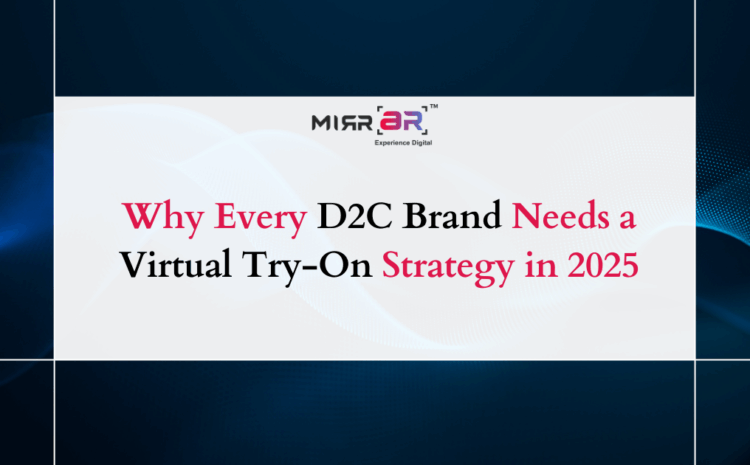Direct-to-Consumer (D2C) brands have disrupted retail by building stronger connections with customers, cutting out intermediaries, and offering unique, personalized experiences. But as we enter 2025, the competition in the D2C space has reached new heights. With thousands of brands vying for consumer attention across social media, e-commerce platforms, and apps, the real differentiator is no longer just product quality—it’s the shopping experience.
This is where Virtual Try-On (VTO) comes into play. Once considered a futuristic gimmick, VTO is now a mainstream necessity for D2C brands aiming to enhance engagement, reduce returns, and earn customer trust. Let’s dive into why every D2C brand needs a Virtual Try-On strategy in 2025.
Rising Customer Expectations in 2025
Consumers today are not content with browsing static images or reading long product descriptions. They expect interactive, personalized, and frictionless shopping journeys. From AR-powered filters on social media to AI-driven recommendations, digital natives are already accustomed to immersive experiences.
For D2C brands, this shift means they must go beyond traditional online catalogs. VTO allows shoppers to see products on themselves—whether it’s a pair of sneakers, a saree, or a shade of lipstick—bridging the gap between imagination and reality. In 2025, failing to offer this level of interactivity risks making a brand feel outdated.
Building Confidence and Reducing Returns
One of the biggest hurdles for online shoppers is uncertainty. “Will this fit me?” “Will this color suit my skin tone?” “Will this accessory match my style?” These doubts often lead to abandoned carts or multiple size/color orders that end up being returned.
D2C brands, which operate with tighter margins compared to large retailers, can’t afford high return rates. VTO helps solve this by enabling shoppers to visualize products realistically before purchasing. When customers feel confident in their choices, they’re less likely to return items. This not only protects profit margins but also builds trust in the brand.
Engagement That Drives Conversions
D2C brands thrive on direct engagement with their audience. Unlike traditional retail, where shelf space matters, D2C success hinges on how well a brand captures and sustains customer attention online.
Virtual Try-On is inherently engaging. Shoppers spend more time on product pages, experiment with variations, and often share their try-on experiences with friends or on social media. This level of interaction leads to deeper brand connections and higher conversion rates. In fact, studies show that customers who use VTO are significantly more likely to complete a purchase compared to those who only browse static images.
Standing Out in a Crowded Market
The D2C ecosystem is crowded with competitors offering similar products at comparable price points. To break through the noise, brands must provide something extra—a reason for customers to stop scrolling and start engaging.
VTO serves as that differentiator. Imagine two skincare brands selling foundation online: one offers a shade-matching VTO tool, while the other provides only a swatch chart. The choice for the consumer becomes obvious. By investing in VTO, D2C brands signal that they’re innovative, customer-centric, and ahead of the curve.
Data-Driven Personalization
Another major advantage of VTO is the wealth of insights it provides. Every interaction—whether it’s trying different sizes, colors, or styles—gives brands valuable data about customer preferences. D2C businesses can leverage this data to personalize recommendations, fine-tune inventory, and even design future products.
For example, if VTO data reveals that a large portion of users prefer darker shades of a particular lipstick, a D2C beauty brand can adjust its production strategy accordingly. This level of data-driven decision-making strengthens customer loyalty while minimizing wasted resources.
Sustainability and Reduced Waste
In 2025, sustainability isn’t just a buzzword—it’s a customer expectation. Shoppers, especially Gen Z and millennials, want to support brands that align with their values. High return rates not only hurt profits but also create a massive environmental footprint due to packaging waste and reverse logistics.
By helping customers make accurate decisions before purchasing, VTO reduces the number of returns and the associated waste. This makes it a critical tool for D2C brands aiming to position themselves as eco-conscious while also optimizing their bottom line.
Seamless Integration with Social Commerce
Social media platforms have become the lifeblood of D2C marketing. Instagram, TikTok, and Snapchat already allow AR filters where users can “try on” products virtually. Forward-thinking D2C brands can seamlessly integrate their VTO strategies with social commerce, turning engagement into direct sales.
Imagine a customer trying on sunglasses through a TikTok filter and being able to buy them instantly through the brand’s link. This kind of immersive shopping blurs the line between marketing and conversion, creating a win-win for both customers and brands.
Future-Proofing the Brand
As technology continues to evolve, consumer behaviors will only become more immersive and digitally driven. VTO is not just a short-term trend; it’s the foundation of future shopping experiences in the metaverse and beyond.
D2C brands that invest in VTO now will be better positioned to adapt to these shifts, while those that ignore it may struggle to stay relevant. A strong VTO strategy today ensures a brand can scale tomorrow, whether that means expanding into AR-powered fashion shows or personalized metaverse storefronts.
Final Thoughts
For D2C brands in 2025, Virtual Try-On is no longer optional—it’s essential. From reducing returns and increasing conversions to driving engagement and supporting sustainability, the ROI of VTO is clear and measurable.
More importantly, it aligns perfectly with the D2C ethos of building direct, authentic relationships with customers. By adopting a Virtual Try-On strategy, D2C brands can transform online shopping into a personalized, confident, and delightful experience—one that keeps customers coming back again and again.
In the crowded digital marketplace, VTO isn’t just a tool—it’s the edge every D2C brand needs to thrive in 2025.
